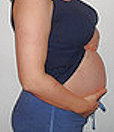|
Braxton Hicks Contractions
|
Though the exact reason for them remains unknown, they are thought to occur so as to help pump blood through the sinuses of veins in the muscles of the uterus, moving blood from some of the large veins of the uterus where stagnation could occur.
Braxton Hicks contractions occur through out pregnancy. They can be felt by some women from as early as the 12th week of pregnancy, but their intensity increases and becomes more noticeable from the 30th week of pregnancy. This is because of the increased size of the uterus. These contraction are often felt earlier by expectant mothers who have had previous babies and the pain may be more intense in such mothers.
If the contractions are strong enough, as have been reported in some expectant mothers, they could be so painful as to lead to great discomfort and tears!
Some expectant mothers have been woken up from their sleep by these contractions.
Dehydration, tiredness or straining one’s self could trigger a contractions.
It is very important to differentiate a Braxton Hicks contraction from real contractions of labour or true labor, to avoid getting caught and having a baby unexpectedly in a less than ideal time or place. Or both. The following signs and symptoms of braxton hicks will help to make that differentiation.
Signs and Symptoms of Braxton Hicks |
The following are signs and symptoms of Braxton Hicks:
- Braxton Hicks contractions are not regular in nature and are felt as a tightening cramps on the abdomen for a few seconds to minutes. The abdominal wall could become like rock solid for a few seconds and then relaxes. When felt with the hand, the hardness could be localized to a part of the uterus. After a few seconds to minutes, the contraction is followed by relaxation
- These contractions could occur as early as the 12th to 16th week of pregnancy, but more often after the 20th to 30th week
- They present as irregular contractions. This means that there may be no pattern to the manner of contractions. You could have one contraction in every five minutes or every hour. Each contraction could last for a few seconds to minutes. They can keep reoccurring continuously for weeks or months
- The contractions may be significant enough to take your breath away. It could also be felt as a dull ache or even painful
- If you have regular painful uterine contractions coming on up to more than two (2) times within every 10 minutes, it is likely you are in labor, and should seek medical attention immediately.
Difference between Braxton Hicks Contraction and True Labour |
As said above, it is important to differentiate Braxton Hicks contraction from true labor. Failure to do this may lead to premature birth of your baby.
True labor is differentiated from Braxton Hicks contraction or false labor by the following:
- Genuine labor contraction starts steadily and gets stronger over time (hours), as different from braxton hicks that causes pain (if painful) of the same intensity over days, though the severity of discomfort could be more as the pregnancy advances
- Real contractions (labor) pain starts from the back and spread over to the abdomen, while braxton hicks contraction pain starts from the abdomen, on top of the uterus, pulling downward towards the groin and then disappears
Real contractions due to labour is not stopped by change in activity, whereas, if you are having a braxton hicks contraction, change of position or activity will abort the contraction. So if you are not sure if your pain is due to true labour, change your position now and see if it will go away
- In early labor, the contractions could be as frequent as every 4 to 15 minutes, and each contractions lasting for 30 – 60 seconds. A Braxton Hicks contraction should last less then 30 seconds, though on rare occasions, it could last up to 2 minutes
- There may be a "show": thick slim or mucus mixed with blood from the cervix, coming through as a secretion in true labour, while such is not expected in false labor.
As a guide, if you have moderate abdominal pain or contractions of up to 4 episodes in an hour continuously not relieved by changing your activity, it is always safest to call your midwife or doctor, just in case you have gone into real labor.
Overcoming Painful Braxton Hicks Contraction |
So you think it’s Braxton Hicks contractions you are experiencing? Then help yourself to relieving it now. Do the following:
- Get a cold refreshing drink, or make your self a warm drink / tea if you prefer
- If you were resting when the contractions started, get up and take a brisk walk. On the other hand, if you were working or active when the contraction started, your body may just be telling you that you need to rest now. Yes. Go. Take a rest!
- If this does not work, try take a bath or shower
- Some tablets of paracetamol may help if the discomfort is so severe
- If the contractions are still present after all the above steps, then call your midwife or doctor for an urgent assessment. This may be a preterm or true labor.
References:
- Peter M Dunn. John Braxton Hicks (1823–97) and Painless Uterine Contractions. Arch Dis Child Fetal Neonatal Ed 1999;81:F157-F158 doi:10.1136/fn.81.2.F157.
- Susan Scott Ricci. Difference Between True and False Labor. Maternity and pediatric nursing By Susan Scott Ricci, Terri Kyle. 2009. Page 361 - 362
Related Links & Resources:
Other Causes of Abdominal Pain In Pregnancy
Causes of Abdominal Pain in Early Pregnancy
American Express International Health Care Plan Application
Return To HomePage From Braxton Hicks Contractions Page



